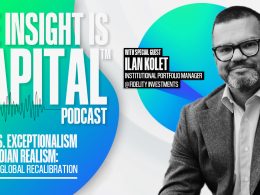by Christopher Gannatti, CFA Global Head of Research, WisdomTree
Key Takeaways
- Nvidia’s strong performance in the first half of 2024 has been a determining factor in the performance of technology-focused ETFs, with more weight to Nvidia resulting in stronger performance and less weight resulting in weaker performance.
- WisdomTree has three broad-based technology-oriented thematic ETFs: the WisdomTree Artificial Intelligence and Innovation Fund (WTAI), WisdomTree Cloud Computing Fund (WCLD) and WisdomTree Cybersecurity Fund (WCBR).
- The market performance of software-oriented strategies has been challenging, but the use of AI will rely on software and cybersecurity solutions, indicating the importance of these areas in the AI megatrend.
Why is [insert name of technology-focused ETF] underperforming in 2024?
This is a recurring question that we are facing in June 2024. Part of the reason is that, while we spend all this time trying to formulate more complete exposures to different technology-oriented thematic equity areas, Nvidia has been performing so strongly that performance so far in 2024 has been determined by:
- More weight to Nvidia = Stronger performance
- Less weight to Nvidia = Weaker performance
We readily admit that we even published a blog post focusing on the risk of being “too exposed” to Nvidia within ETF strategies in March 2024 when Nvidia was hitting a market capitalization of $2 trillion. Roughly three months later, we sit looking at Nvidia with a market capitalization of around $3 trillion. If there is a risk, it hasn’t yet materialized in the form of significantly negative returns.
Three Broad-Based Technology-Oriented Thematic ETFs Can Tell Us A Lot
When we think about technology-oriented ETFs in our U.S. thematic range, we tend to discuss:
- The WisdomTree Artificial Intelligence and Innovation Fund (WTAI): This strategy is designed to track the total returns, before fees and expenses, of the WisdomTree Artificial Intelligence and Innovation Index. It divides what we view as the complete AI ecosystem into four areas: semiconductors, software, other hardware and innovative use cases. Historically, the exposure to Nvidia within this strategy has been in the range of 2%–3%, among the larger exposures in this diversified approach, but also not a large bet.
- The WisdomTree Cloud Computing Fund (WCLD): This strategy is designed to track the total returns, before fees and expenses, of the BVP Nasdaq Emerging Cloud Index. This index is rebalanced back to equal weight twice a year and focuses on business-oriented firms that derive more than 50% of their revenues from cloud computing. It is a diversified array of Software-as-a-Service (SaaS) companies. Being a software-oriented portfolio, it has no exposure to semiconductor companies.
- The WisdomTree Cybersecurity Fund (WCBR): This strategy is designed to track the total returns, before fees and expenses, of the WisdomTree Team8 Cybersecurity Index. The focus is on pure-play cybersecurity companies that deliver exposure to at least one of eight distinct cybersecurity themes defined by Team8 and monitored at semi-annual rebalances each year. Semiconductors are not a focus in this strategy and have had zero weight historically.
These strategies tend to provide the bulk of their exposure within the software (WCLD and WCBR) and semiconductors (WTAI) industries. While Nvidia is the first semiconductor name that people are thinking about—and have been thinking about for some 18 months—there is a much longer tail of notable companies that can benefit significantly IF consumers and businesses are inspired to update their hardware and buy AI-enabled devices, largely laptops and smartphones. Apple just announced its Apple Intelligence suite of functionality, completing the picture and allowing even those in the Apple universe of products to have this option. 1
It's also interesting that, if one looks at the market performance, it feels like people cannot get far enough away from most software-oriented strategies. WCLD and WCBR, of late, have been running into the wind. However, if people are really excited about AI—essentially, what we will be using the Nvidia chips for—the way in which it will be used is through software. We will also need a lot of cybersecurity solutions to ensure a potentially safer experience.
As we watch the software space today, we are seeking to find those companies that embrace AI and are providing innovative solutions that appear to stack up strongly against the large, generalized foundation models, be it GPT-4o, Microsoft Copilot or Google Gemini, to name a few.
Current Consensus, Forward Guidance and Returns
If we create a list of all the constituents within WTAI, WCLD and WCBR, we can order it based on changes to forward guidance as of the most recent quarterly earnings report. The thinking here is that companies particularly confident in their prospects this year will be raising guidance more significantly, and those really concerned about their prospects will be lowering guidance. When we have read recent reports on earnings announcements, there has been a lot of focus on guidance for the coming quarter and rest of 2024.
Guidance, in a sense, represents a datapoint that bakes in a company’s own forward-looking expectations.
- Five of the 10 best forward sales revision firms, post-guidance, were in a semiconductor-related sub-industry. Nvidia was there, but people may not have immediately predicted the presence of Ambarella, Analog Devices, Teradyne or GlobalFoundries. Teradyne, Nvidia and Ambarella delivered double-digit returns seven days after their announcements.
- The tides of returns in software stocks can change quickly, and we see Monday.com, DigitalOcean, Zscaler and CrowdStrike all raising guidance, at least by a small amount. CrowdStrike and Monday.com each saw their shares up by more than 25% seven days after their announcements.
- Software-as-a-Service has been tough. UiPath, Fastly and Sprout Social are examples of companies that lowered their revenue guidance in their most recent announcements. Shares of these three companies were all down by more than 35% seven days after this information hit the tape.
- Of the companies in the 10 Worst Forward Sales Revision group, post-guidance, Salesforce got a significant amount of negative attention—we think too much. Salesforce basically met consensus expectations and then lowered guidance by a small amount. To see a company of this stature—companies that use Salesforce for their client data cannot simply stop on a dime—losing 20% of its market capitalization in one day is a huge move. Maybe one interpretation is that the market wants to see more from Salesforce with respect to generative AI integrations.
Figure 1: Current Consensus, Forward Guidance and Returns, as of June 11, 2024

Sources: WisdomTree, FactSet. As of 6/11/24, we sought companies within WTAI, WCLD or WCBR as constituents and looked at their most recent
earnings announcement, any change to forward guidance, and subsequent returns from that announcement to try to gauge reaction to that
specific announcement. Holdings subject to change.
Conclusion: The AI Megatrend Is Bigger than Nvidia
It’s possible that market participants are starting to believe that nothing is bigger than Nvidia. We are always keeping in mind that building out compute infrastructure is merely one step within the AI journey. The bigger and more important step involves thinking about what we will be using all of this compute infrastructure for.
In the near term, we have seen companies announcing an array of options for those looking for AI-enabled smartphones. Samsung, Apple and Google are all tossing their respective hats into the ring. Additionally, AI is starting to be infused into the operating system of new laptops and tablets. We are watching the sales figures for these devices because if we see significant sales in 2024 heading into 2025, it goes a long way to making AI ubiquitous. It will make using AI-enabled applications become more normalized and speed the transition to the next stage of computing. We’ll also have to keep thinking about cybersecurity throughout.
WTAI, WCLD and WCBR, albeit in different ways, capture different parts of this technological evolution.
1 Source: “Apple Intelligence Preview.” Apple, www.apple.com/apple-intelligence/.
2 Sources: WisdomTree, FactSet. As of 6/11/24, we sought companies within WTAI, WCLD or WCBR as constituents and looked at their most recent earnings announcement, any change to forward guidance and subsequent returns from that announcement to try to gauge reaction to that specific announcement.














